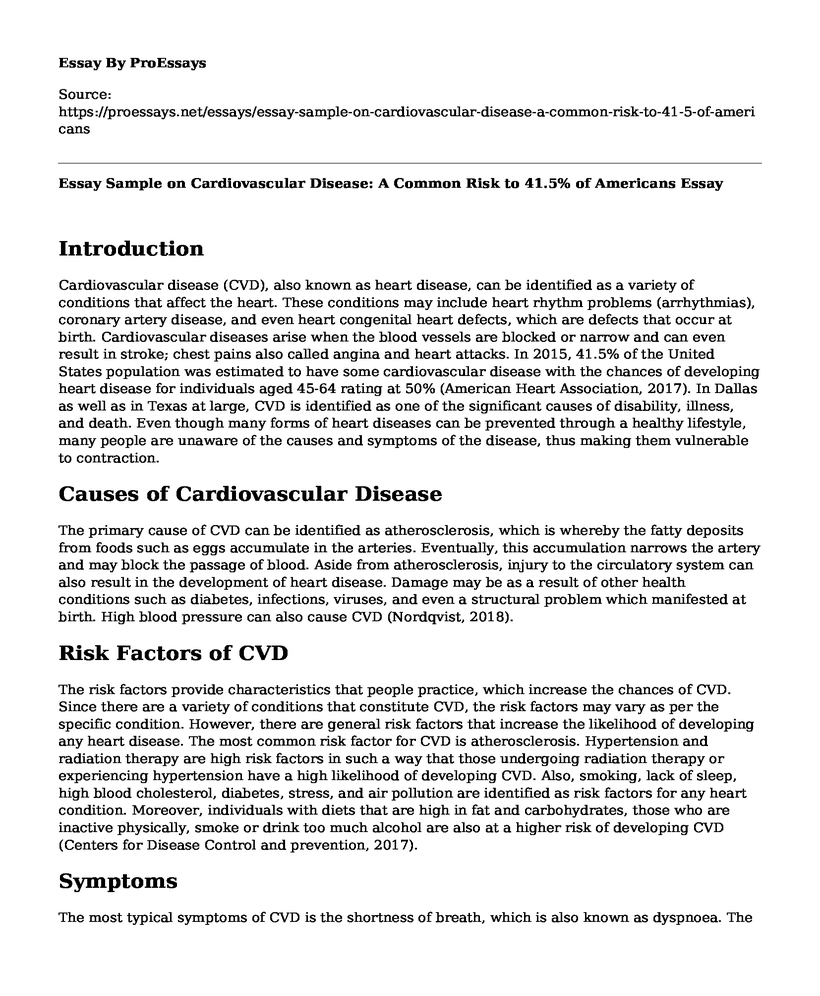Introduction
Cardiovascular disease (CVD), also known as heart disease, can be identified as a variety of conditions that affect the heart. These conditions may include heart rhythm problems (arrhythmias), coronary artery disease, and even heart congenital heart defects, which are defects that occur at birth. Cardiovascular diseases arise when the blood vessels are blocked or narrow and can even result in stroke; chest pains also called angina and heart attacks. In 2015, 41.5% of the United States population was estimated to have some cardiovascular disease with the chances of developing heart disease for individuals aged 45-64 rating at 50% (American Heart Association, 2017). In Dallas as well as in Texas at large, CVD is identified as one of the significant causes of disability, illness, and death. Even though many forms of heart diseases can be prevented through a healthy lifestyle, many people are unaware of the causes and symptoms of the disease, thus making them vulnerable to contraction.
Causes of Cardiovascular Disease
The primary cause of CVD can be identified as atherosclerosis, which is whereby the fatty deposits from foods such as eggs accumulate in the arteries. Eventually, this accumulation narrows the artery and may block the passage of blood. Aside from atherosclerosis, injury to the circulatory system can also result in the development of heart disease. Damage may be as a result of other health conditions such as diabetes, infections, viruses, and even a structural problem which manifested at birth. High blood pressure can also cause CVD (Nordqvist, 2018).
Risk Factors of CVD
The risk factors provide characteristics that people practice, which increase the chances of CVD. Since there are a variety of conditions that constitute CVD, the risk factors may vary as per the specific condition. However, there are general risk factors that increase the likelihood of developing any heart disease. The most common risk factor for CVD is atherosclerosis. Hypertension and radiation therapy are high risk factors in such a way that those undergoing radiation therapy or experiencing hypertension have a high likelihood of developing CVD. Also, smoking, lack of sleep, high blood cholesterol, diabetes, stress, and air pollution are identified as risk factors for any heart condition. Moreover, individuals with diets that are high in fat and carbohydrates, those who are inactive physically, smoke or drink too much alcohol are also at a higher risk of developing CVD (Centers for Disease Control and prevention, 2017).
Symptoms
The most typical symptoms of CVD is the shortness of breath, which is also known as dyspnoea. The individual may also experience chest pains as an indication of angina, nausea, fainting, fatigue cold sweat and pain in the arms, elbows, left shoulder back or the jaw (Nordqvist, 2018). The symptoms of CVD may vary according to the specific condition.
Effects of CVD on the Individual
Despite the physical pain or disability or even increased chances of death that is caused by CVD, an individual with any heart disease will experience immense economic expenditure. The high costs incurred result from medication as well as lifestyle and dietary expenses that are necessary to prevent the condition from worsening. As the number one cause of death in all of Texas, CVD is also one of the factors that drain the resources for the health care sector. The disabilities developed from heart diseases require specific care that is offered by professionals and therefore translating to more costs. Therefore, to curb the chances of heart diseases among individuals aged 45-64, it is essential to create awareness on the risk factors that contribute to the development of heart diseases.
References
American Heart Association. (2017). Cardiovascular Disease: A Costly Burden for America Projections Through 2035. Retrieved from American Heart Association website: https://healthmetrics.heart.org/cardiovascular-disease-a-costly-burden/
Centers for Disease Control and prevention. (2017, January 8). Heart Disease Fact Sheet. Retrieved from Division for Heart Disease and Stroke Prevention website: https://www.cdc.gov/dhdsp/data_statistics/fact_sheets/fs_heart_disease.htm
Nordqvist, C. (2018, January 24). Cardiovascular disease: Symptoms, types, treatments, and causes. Retrieved from https://www.medicalnewstoday.com/articles/257484.php
Cite this page
Essay Sample on Cardiovascular Disease: A Common Risk to 41.5% of Americans. (2023, Jan 24). Retrieved from https://proessays.net/essays/essay-sample-on-cardiovascular-disease-a-common-risk-to-41-5-of-americans
If you are the original author of this essay and no longer wish to have it published on the ProEssays website, please click below to request its removal:
- Issues in Social Work
- Addressing New Jersey's Opiate Issue - Sociology Essay Example
- What is a Professional Nurse? - Essay Sample
- Essay Sample on Nursing Advocacy and Politics
- Essay Sample on Beating HIV: How Medication Can Help Protect Your Health
- Biometric Health Record System: A Solution to Health Records Management - Essay Sample
- Patient Falls: A National Health Service Overview - Research Paper







